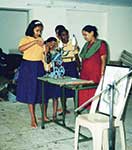Arun Elassery
I would have our young men and young women learn as much of English and other world languages as they like, and then expect them to give the benefits of their learning to India and the outside world… But I would not have a single Indian forget, neglect or be ashamed of his mother tongue, or to feel that he or she cannot think or express the best thoughts in his or her own vernacular. – Mahatma Gandhi
When I explained to Vidya Patwardhan that I was going around the country collecting alternative school stories, she wrote back: “Well, Aksharnandan is a mainstream school, exploring innovative spaces within. So cannot really be called ‘Alternative’.”
 As she graciously showed me around Aksharnandan in Pune, Vidya told me how it all began. Vidya, who has an MA and an MPhil in Anthropology, was working as a teacher trainer at the NG Naralkar Foundation. She felt that the work she was doing had limited impact on the triangle of teaching/learning/evaluation. This insight became the seed for a group of like-minded persons from varied walks of life to come together to form Aksharnandan. In addition to integrating information, knowledge, values, and skills, Aksharnandan anchored itself firmly on the following pillars –
As she graciously showed me around Aksharnandan in Pune, Vidya told me how it all began. Vidya, who has an MA and an MPhil in Anthropology, was working as a teacher trainer at the NG Naralkar Foundation. She felt that the work she was doing had limited impact on the triangle of teaching/learning/evaluation. This insight became the seed for a group of like-minded persons from varied walks of life to come together to form Aksharnandan. In addition to integrating information, knowledge, values, and skills, Aksharnandan anchored itself firmly on the following pillars –
a. Using vernacular (Marathi) as the medium of learning.
b. Focusing on a cooperative, non-competitive environment
c. Building sensitivity to ecology and environment.
d. Following democratic values.
e. Integrating Head, Hand, and Heart (3Hs).
f. Making the school inclusive.
(Point’a’above is a problem that we readers and writers of English, even when we are proficient in other India languages, hugely underestimate and Aksharnandan’s website echoes Gandhiji as it states: “A truly universal mind can grow, only when it strikes strong roots in its indigenous soil.”)
As we walked through the non-box-like architecture of the school’s new building, what was very noticeable was the children’s art and writing work displayed over all the walls. On one wall I remember a large painted tree with hidden animals in it, and I noticed that a snail shell stuck on the wall looked very real. We peeped into some classrooms and I saw children, quite relaxed, sitting in small groups and quietly working on furniture-less floors. In the rooms where the teacher was talking, the children faced her but even here it didn’t look like a ‘class’. I also got a glimpse of a child sleeping with his knees up on a low bench in the corner of one of the classrooms.
Two stories Vidya told me highlight the teaching/learning methodology they follow at Aksharnandan. Children in class VI working in groups follow bank procedures to get loans of Rs. 500 to Rs. 700 that the school facilitates. The children use the money to buy raw materials to create artifacts that they then sell. The other story is that many activities that integrate head, heart, and hands are done by all the children in all the classes. Cooking, Vidya thinks, is an especially good example.
 My visit to Aksharnandan renewed my faith in how much difference a small group of determined, compassionate individuals can make. In my thank you mail to Vidya, I wrote:
My visit to Aksharnandan renewed my faith in how much difference a small group of determined, compassionate individuals can make. In my thank you mail to Vidya, I wrote:
“Thank you for the time you took out of your busy schedule to meet me. It was wonderful getting to spend time in the circle of your wisdom and warmth. I came away really inspired by what you have done at Aksharnandan. You said that you are ‘mainstream’, well, I think that many ‘alternative’ schools can learn some basics about real education from Aksharnandan.”
I thought Vidya’s response proved my point:
“Arun, I also enjoyed talking to you. ‘Circle of wisdom and warmth’! Well put, Arun, but a bit exaggerated. Would love to meet your family, perhaps next time I’m in Kerala.”
I think ‘wisdom and warmth’ it is, and that is probably what reflects from everything in the unique ‘mainstream’ experiment called Aksharnandan.
Quick facts
Name of the school: Aksharnandan
Been around for: 23 years (started in June 1992)
Number of teachers/staff: 20 full time and 25 contributory (part time)
Number of children: 484 (40 students in one class and no class divisions)
Classes handled: KG to 10
USP: Marathi medium school that follows democratic values and propagates a non-competitive, ecologically sensitive worldview interweaving academic studies with productive activities.
Approximate fees per child: Rs 15,800 per annum for KG to Rs 18,000 per annum for high school (75% students are fee paying and 25% are non-fee paying under RTE)
Location: Pune
Website: http://www.aksharnandanschool.org
The author got his degree from IIT Kharagpur in 1988 and is currently a Wipro Education Fellow. He can be reached at arunelassery@hotmail.com.
